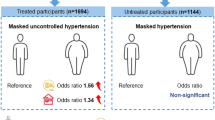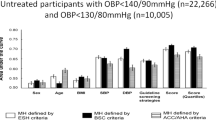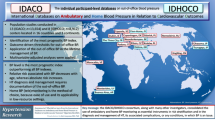Abstract
Masked hypertension is defined as a normal blood pressure (BP) in the clinic or office (<140/90 mmHg), but an elevated BP out of the clinic (ambulatory daytime BP or home BP>135/85 mmHg). It may occur in as many as 10% of the general population, and is important because it is not diagnosed by routine medical examinations, but carries an adverse prognosis, both in terms of increased target organ damage and cardiovascular events. Possible characteristics of individuals with masked hypertension are: relatively young age, male sex, stress or increased physical activity during the daytime, and smoking or drinking habits. Masked hypertension has also been described in treated hypertensive patients (in whom the prognosis is worse than predicted from the clinic pressure) and in children, in whom it may be a precursor of sustained hypertension. It may be suspected in individuals who have a history of occasional high BP readings, but who are apparently normotensive when checked in the office. One practical point is that we should continue to follow such people rather than dismissing them, and encourage out-of-clinic monitoring of BP. This would apply particularly to smokers and those with BP in the prehypertensive range. The potential implications of masked hypertension are huge, but the optimal strategy for detecting the condition in the general population is not yet clear.
Similar content being viewed by others
Article PDF
References
Ayman P, Goldshine AD : Blood pressure determinations by patients with essential hypertension I. The difference between clinic and home readings before treatment. Am J Med Sci 1940; 200: 465–474.
Alam M, Smirk FM : Casual and basal blood pressures. I. In British and Egyptian men. Brit Heart J 1943; 5: 152–160.
Sokolow M, Werdegar D, Kain HK, Hinman AT : Relationship between level of blood pressure measured casually and by portable recorders and severity of complications in essential hypertension. Circulation 1966; 34: 279–298.
Perloff D, Sokolow M, Cowan R : The prognostic value of ambulatory blood pressures. JAMA 1983; 249: 2792–2798.
Imai Y, Ohkubo T, Tsuji I, et al: Prognostic value of ambulatory and home blood pressure measurements in comparison to screening blood pressure measurements: a pilot study in Ohasama. Blood Press Monit 1996; 1 ( Suppl 2): S51–S58.
Bobrie G, Chatellier G, Genes N, et al: Cardiovascular prognosis of “masked hypertension” detected by blood pressure self-measurement in elderly treated hypertensive patients. JAMA 2004; 291: 1342–1349.
Verdecchia P, Schillaci G, Borgioni C, Ciucci A, Porcellati C : White-coat hypertension: not guilty when correctly defined. Blood Press Monit 1998; 3: 147–152.
Mancia G : Reversed white-coat hypertension: definition, mechanisms and prognostic implications. J Hypertens 2002; 20: 579–581.
Liu JE, Roman MJ, Pini R, Schwartz JE, Pickering TG, Devereux RB : Cardiac and arterial target organ damage in adults with elevated ambulatory and normal office blood pressure. Ann Intern Med 1999; 131: 564–572.
Pickering TG, Davidson K, Gerin W, Schwartz JE : Masked hypertension. Hypertension 2002; 40: 795–796.
Verdecchia P, Schillaci G, Boldrini F, Zampi I, Porcellati C : Variability between current definitions of ‘normal’ ambulatory blood pressure. Implications in the assessment of white coat hypertension. Hypertension 1992; 20: 555–562.
Pickering TG, Coats A, Mallion JM, Mancia G, Verdecchia P : Blood Pressure Monitoring. Task force V: white-coat hypertension. Blood Press Monit 1999; 4: 333–341.
Tachibana R, Tabara Y, Kondo I, Miki T, Kohara K : Home blood pressure is a better predictor of carotid atherosclerosis than office blood pressure in community-dwelling subjects. Hypertens Res 2004; 27: 633–639.
Japanese Society of Hypertension : Japanese Society of Hypertension Guidelines for the Management of Hypertension (JSH 2004). Hypertens Res 2006; 29 ( Suppl): S1–S105.
Kario K, Pickering TG, Matsuo T, Hoshide S, Schwartz JE, Shimada K : Stroke prognosis and abnormal nocturnal blood pressure falls in older hypertensives. Hypertension 2001; 38: 852–857.
Sega R, Facchetti R, Bombelli M, et al: Prognostic value of ambulatory and home blood pressures compared with office blood pressure in the general population: follow-up results from the Pressioni Arteriose Monitorate e Loro Associazioni (PAMELA) study. Circulation 2005; 111: 1777–1783.
Kikuya M, Ohkubo T, Asayama K, et al: Ambulatory blood pressure and 10-year risk of cardiovascular and noncardiovascular mortality: the Ohasama study. Hypertension 2005; 45: 240–245.
Davidson MB, Hix JK, Vidt DG, Brotman DJ : Association of impaired diurnal blood pressure variation with a subsequent decline in glomerular filtration rate. Arch Intern Med 2006; 166: 846–852.
Hoshide S, Ishikawa J, Eguchi K, Ojima T, Shimada K, Kario K : Masked nocturnal hypertension and target organ damage in hypertensives with well-controlled self-measured home blood pressure. Hypertens Res 2007; 30: 143–149.
James GD, Pickering TG, Yee LS, Harshfield GA, Riva S, Laragh JH : The reproducibility of average ambulatory, home, and clinic pressures. Hypertension 1988; 11 ( 6 Pt 1): 545–549.
Guida L, Iannuzzi R, Crivaro M, et al: Clinic-daytime blood pressure difference and cardiovascular damage. J Hypertens 1999; 17: 331–337.
Lantelme P, Milon H, Vernet M, Gayet C : Difference between office and ambulatory blood pressure or real white coat effect: does it matter in terms of prognosis? J Hypertens 2000; 18: 383–389.
Kristensen KS, Hoegholm A, Bang LE, Gustavsen PH, Poulsen CB : No impact of blood pressure variability on microalbuminuria and left ventricular geometry: analysis of daytime variation, diurnal variation and ‘white coat’ effect. Blood Press Monit 2001; 6: 125–131.
Verdecchia P, Schillaci G, Borgioni C, Ciucci A, Porcellati C : Prognostic significance of the white coat effect. Hypertension 1997; 29: 1218–1224.
Parati G, Ulian L, Santucciu C, Omboni S, Mancia G : Difference between clinic and daytime blood pressure is not a measure of the white coat effect. Hypertension 1998; 31: 1185–1189.
Palatini P, Palomba D, Bertolo O, et al: The white-coat effect is unrelated to the difference between clinic and daytime blood pressure and is associated with greater reactivity to public speaking. J Hypertens 2003; 21: 545–553.
Munakata M, Saito Y, Nunokawa T, Ito N, Fukudo S, Yoshinaga K : Clinical significance of blood pressure response triggered by a doctor's visit in patients with essential hypertension. Hypertens Res 2002; 25: 343–349.
Rostrup M, Kjeldsen SE, Eide IK : Awareness of hypertension increases blood pressure and sympathetic responses to cold pressor test. Am J Hypertens 1990; 3 ( 12 Pt 1): 912–917.
Rostrup M, Mundal HH, Westheim A, Eide I : Awareness of high blood pressure increases arterial plasma catecholamines, platelet noradrenaline and adrenergic responses to mental stress. J Hypertens 1991; 9: 159–166.
Mann SJ, James GD, Wang RS, Pickering TG : Elevation of ambulatory systolic blood pressure in hypertensive smokers. A case-control study. JAMA 1991; 265: 2226–2228.
Wing LM, Brown MA, Beilin LJ, Ryan P, Reid CM : ‘Reverse white-coat hypertension’ in older hypertensives. J Hypertens 2002; 20: 639–644.
Bobrie G, Genes N, Vaur L, et al: Is “isolated home” hypertension as opposed to “isolated office” hypertension a sign of greater cardiovascular risk? Arch Intern Med 2001; 161: 2205–2211.
Selenta C, Hogan BE, Linden W : How often do office blood pressure measurements fail to identify true hypertension? An exploration of white-coat normotension. Arch Fam Med 2000; 9: 533–540.
Schnall PL, Schwartz JE, Landsbergis PA, Warren K, Pickering TG : Relation between job strain, alcohol, and ambulatory blood pressure. Hypertension 1992; 19: 488–494.
Ishikawa J, Kario K, Eguchi K, et al, J-MORE group: Regular alcohol drinking is a determinant of masked morning hypertension detected by home blood pressure monitoring in medicated hypertensive patients with well-controlled clinic blood pressure: the Jichi Morning Hypertension Research (J-MORE) study. Hypertens Res 2006; 29: 679–686.
Leary AC, Donnan PT, MacDonald TM, Murphy MB : The influence of physical activity on the variability of ambulatory blood pressure. Am J Hypertens 2000; 13: 1067–1073.
Julius S, Li Y, Brant D, Krause L, Buda AJ : Neurogenic pressor episodes fail to cause hypertension, but do induce cardiac hypertrophy. Hypertension 1989; 13: 422–429.
Belkic KL, Schnall PL, Landsbergis PA, et al: Hypertension at the workplace—an occult disease? The need for work site surveillance. Adv Psychosom Med 2001; 22: 116–138.
Sega R, Trocino G, Lanzarotti A, et al: Alterations of cardiac structure in patients with isolated office, ambulatory, or home hypertension: data from the general population (Pressione Arteriose Monitorate e Loro Associazioni [PAMELA] Study). Circulation 2001; 104: 1385–1392.
Ohkubo T, Kikuya M, Metoki H, et al: Prognosis of “masked” hypertension and “white-coat” hypertension detected by 24-h ambulatory blood pressure monitoring 10-year follow-up from the Ohasama study. J Am Coll Cardiol 2005; 46: 508–515.
Matsui Y, Eguchi K, Ishikawa J, Hoshide S, Shimada K, Kario K : Subclinical arterial damage in untreated masked hypertensive subjects detected by home blood pressure measurement. Am J Hypertens 2007; 20: 385–391.
Imai Y, Nagai K, Sakuma M, et al: Ambulatory blood pressure of adults in Ohasama, Japan. Hypertension 1993; 22: 900–912.
O'Brien E, Murphy J, Tyndall A, et al: Twenty-four-hour ambulatory blood pressure in men and women aged 17 to 80 years: the Allied Irish Bank Study. J Hypertens 1991; 9: 355–360.
Mancia G, Sega R, Bravi C, et al: Ambulatory blood pressure normality: results from the PAMELA study. J Hypertens 1995; 13 ( 12 Pt 1): 1377–1390.
Rasmussen SL, Torp-Pedersen C, Borch-Johnsen K, Ibsen H : Normal values for ambulatory blood pressure and differences between casual blood pressure and ambulatory blood pressure: results from a Danish population survey. J Hypertens 1998; 16: 1415–1424.
Manning G, Rushton L, Millar-Craig MW : Twenty-four hour ambulatory blood pressure: a sample from a normal British population. J Hum Hypertens 1998; 12: 123–127.
Imai Y, Tsuji I, Nagai K, et al: Ambulatory blood pressure monitoring in evaluating the prevalence of hypertension in adults in Ohasama, a rural Japanese community. Hypertens Res 1996; 19: 207–212.
Björklund K, Lind L, Zethelius B, Andren B, Lithell H : Isolated ambulatory hypertension predicts cardiovascular morbidity in elderly men. Circulation 2003; 107: 1297–1302.
Kawabe H, Saito I, Saruta T : Status of home blood pressure measured in morning and evening: evaluation in normotensives and hypertensives in Japanese urban population. Hypertens Res 2005; 28: 491–498.
Lurbe E, Torro I, Alvarez V, et al: Prevalence, persistence, and clinical significance of masked hypertension in youth. Hypertension 2005; 45: 493–498.
Stabouli S, Kotsis V, Toumanidis S, Papamichael C, Constantopoulos A, Zakopoulos N : White-coat and masked hypertension in children: association with target-organ damage. Pediatr Nephrol 2005; 20: 1151–1155.
Shahab ST, Gudbrandsson T, Jamerson K, Julius S : Isolated “home hypertension” in Tecumseh, Michigan. Croat Med J 1993; 34: 325–331.
Stergiou GS, Salgami EV, Tzamouranis DG, Roussias LG : Masked hypertension assessed by ambulatory blood pressure versus home blood pressure monitoring: is it the same phenomenon? Am J Hypertens 2005; 18: 772–778.
Obara T, Ohkubo T, Kikuya M, et al: Prevalence of masked uncontrolled and treated white-coat hypertension defined according to the average of morning and evening home blood pressure value: from the Japan Home versus Office Measurement Evaluation Study. Blood Press Monit 2005; 10: 311–316.
Mallion JM, Genes N, Vaur L, et al: Detection of masked hypertension by home blood pressure measurement: is the number of measurements an important issue? Blood Press Monit 2004; 9: 301–305.
Palatini P, Winnicki M, Santonastaso M, et al: Prevalence and clinical significance of isolated ambulatory hypertension in young subjects screened for stage 1 hypertension. Hypertension 2004; 44: 170–174.
Mancia G, Facchetti R, Bombelli M, Grassi G, Sega R : Long-term risk of mortality associated with selective and combined elevation in office, home, and ambulatory blood pressure. Hypertension 2006; 47: 846–853.
Pierdomenico SD, Lapenna D, Bucci A, et al: Cardiovascular outcome in treated hypertensive patients with responder, masked, false resistant, and true resistant hypertension. Am J Hypertens 2005; 18: 1422–1428.
Schillaci G, Verdecchia P, Sacchi N, et al: Clinical relevance of office underestimation of usual blood pressure in treated hypertension. Am J Hypertens 2000; 13 ( 5 Pt 1): 523–528.
Cuspidi C, Lonati L, Sampieri L, et al: Prevalence of target organ damage in treated hypertensive patients: different impact of clinic and ambulatory blood pressure control. J Hypertens 2000; 18: 803–809.
Burt VL, Whelton P, Roccella EJ, et al: Prevalence of hypertension in the US adult population. Results from the Third National Health and Nutrition Examination Survey, 1988–1991. Hypertension 1995; 25: 305–313.
Author information
Authors and Affiliations
Corresponding author
Rights and permissions
About this article
Cite this article
Pickering, T., Eguchi, K. & Kario, K. Masked Hypertension: A Review. Hypertens Res 30, 479–488 (2007). https://doi.org/10.1291/hypres.30.479
Received:
Accepted:
Issue Date:
DOI: https://doi.org/10.1291/hypres.30.479
Keywords
This article is cited by
-
2023 update and perspectives
Hypertension Research (2024)
-
Masked Hypertension in Healthy Children and Adolescents: Who Should Be Screened?
Current Hypertension Reports (2023)
-
Blood pressure measurement using only a smartphone
npj Digital Medicine (2022)
-
Influence of hypertension and other risk factors on the onset of sublingual varices
BMC Oral Health (2021)
-
Epidemiological Impact and Clinical Consequences of Masked Hypertension: A Narrative Review
High Blood Pressure & Cardiovascular Prevention (2020)



